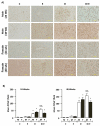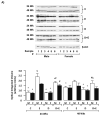Chronic ethanol feeding accelerates hepatocellular carcinoma progression in a sex-dependent manner in a mouse model of hepatocarcinogenesis
- PMID: 22017344
- PMCID: PMC3288433
- DOI: 10.1111/j.1530-0277.2011.01660.x
Chronic ethanol feeding accelerates hepatocellular carcinoma progression in a sex-dependent manner in a mouse model of hepatocarcinogenesis
Abstract
Background: Chronic ethanol consumption increases the risk of hepatic cirrhosis and hepatocellular carcinoma (HCC). While sex differences exist in susceptibility to ethanol-induced liver damage/HCC development, little is known about the effects of ethanol on tumor progression.
Methods: Neonatal male and female mice were initiated with a single dose of diethylnitrosamine (DEN). Sixteen or 40 weeks later, animals were placed on a 10/20% (v/v) ethanol-drinking water (EtOH-DW; alternate days) regime for 8 weeks. At study end, liver tissue and serum were analyzed for liver pathology/function and cytokine expression.
Results: DEN reproducibly induced hepatic foci/tumors in male and female mice. Ethanol diminished hepatic function and increased liver damage, but ethanol alone did not induce hepatic foci/HCC formation. In DEN-initiated EtOH-DW animals, ethanol significantly increased tumor incidence and burden, but only in male mice. Male and female mice (±DEN) demonstrated comparable blood alcohol content at necropsy, yet increased hepatic damage and diminished hepatic function/antioxidant capacity were significantly greater in males. Analysis of liver mRNA for Th1, Th2, or T-regulatory factors demonstrated significantly elevated SMAD3 in male compared to female mice in response to EtOH, DEN initiation, and DEN + EtOH-DW.
Conclusions: These data demonstrate male mice are more susceptible to HCC incidence and progression in the setting of chronic ethanol feeding than females. Differences in markers of hepatic immune response in male mice suggest that increased TGFβ-SMAD3 signaling may enhance promotion in this model of HCC progression, effects modulated by chronic ethanol feeding.
Copyright © 2011 by the Research Society on Alcoholism.
Figures









Comment in
-
Commentary with regard to the role of alcohol and cofactors in the development of hepatocellular carcinoma.Alcohol Clin Exp Res. 2012 Apr;36(4):564-5. doi: 10.1111/j.1530-0277.2012.01780.x. Epub 2012 Mar 13. Alcohol Clin Exp Res. 2012. PMID: 22414007
Similar articles
-
Obesity, but not ethanol, promotes tumor incidence and progression in a mouse model of hepatocellular carcinoma in vivo.Surg Endosc. 2013 Aug;27(8):2782-91. doi: 10.1007/s00464-013-2808-8. Epub 2013 Mar 7. Surg Endosc. 2013. PMID: 23468327
-
Chronic Alcohol Consumption Promotes Diethylnitrosamine-Induced Hepatocarcinogenesis via Immune Disturbances.Sci Rep. 2017 May 31;7(1):2567. doi: 10.1038/s41598-017-02887-7. Sci Rep. 2017. PMID: 28566719 Free PMC article.
-
Diet-induced obesity and ethanol impair progression of hepatocellular carcinoma in a mouse mesenteric vein injection model.Surg Endosc. 2013 Jan;27(1):246-55. doi: 10.1007/s00464-012-2429-7. Epub 2012 Jul 18. Surg Endosc. 2013. PMID: 22806512
-
CYP2E1 potentiates binge alcohol-induced gut leakiness, steatohepatitis, and apoptosis.Free Radic Biol Med. 2013 Dec;65:1238-1245. doi: 10.1016/j.freeradbiomed.2013.09.009. Epub 2013 Sep 21. Free Radic Biol Med. 2013. PMID: 24064383 Free PMC article.
-
Alcohol consumption, Wnt/β-catenin signaling, and hepatocarcinogenesis.Adv Exp Med Biol. 2015;815:185-95. doi: 10.1007/978-3-319-09614-8_11. Adv Exp Med Biol. 2015. PMID: 25427908 Free PMC article. Review.
Cited by
-
Inhibition of diethylnitrosamine-initiated alcohol-promoted hepatic inflammation and precancerous lesions by flavonoid luteolin is associated with increased sirtuin 1 activity in mice.Hepatobiliary Surg Nutr. 2015 Apr;4(2):124-34. doi: 10.3978/j.issn.2304-3881.2014.08.06. Hepatobiliary Surg Nutr. 2015. PMID: 26005679 Free PMC article.
-
Use of a crossed high alcohol preferring (cHAP) mouse model with the NIAAA-model of chronic-binge ethanol intake to study liver injury.Alcohol Alcohol. 2017 Nov 1;52(6):629-637. doi: 10.1093/alcalc/agx063. Alcohol Alcohol. 2017. PMID: 29036399 Free PMC article.
-
ESR1 Regulates the Obesity- and Metabolism-Differential Gene MMAA to Inhibit the Occurrence and Development of Hepatocellular Carcinoma.Front Oncol. 2022 Jun 20;12:899969. doi: 10.3389/fonc.2022.899969. eCollection 2022. Front Oncol. 2022. PMID: 35795061 Free PMC article.
-
Roles of alcohol and tobacco exposure in the development of hepatocellular carcinoma.Life Sci. 2013 Jan 17;92(1):3-9. doi: 10.1016/j.lfs.2012.10.009. Epub 2012 Oct 30. Life Sci. 2013. PMID: 23123447 Free PMC article.
-
Obesity, but not ethanol, promotes tumor incidence and progression in a mouse model of hepatocellular carcinoma in vivo.Surg Endosc. 2013 Aug;27(8):2782-91. doi: 10.1007/s00464-013-2808-8. Epub 2013 Mar 7. Surg Endosc. 2013. PMID: 23468327
References
-
- Albano E, French SW, Ingelman-Sundberg M. Hydroxyethyl radicals in ethanol hepatotoxicity. Front Biosci. 1999;4:D533–40. - PubMed
-
- Castañeda F, Kinne RKH. Cytotoxicity of millimolar concentrations of ethanol on HepG2 human tumor cell line compared to normal rat hepatocytes in vitro. Journal of Cancer Research and Clinical Oncology. 2000;126(9):503–510. - PubMed
Publication types
MeSH terms
Substances
Grants and funding
LinkOut - more resources
Full Text Sources
Medical

